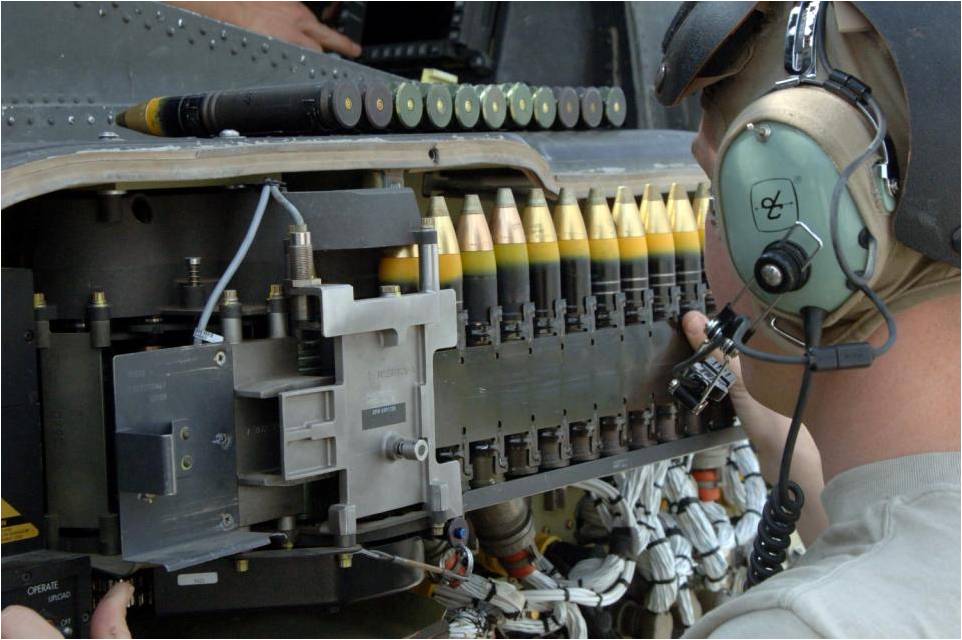
Red. Blue. Green. These aren’t just colors; they are indicators that show potential to enhance the safety of U.S. warfighters. Engineers at Picatinny Arsenal, NJ, are working on a new paint formula that will tell Soldiers if their ammunition is safe to use, based on looking at the color.
These thermal-indicating paints use thermochromic polymers to detect temperature ranges to which ammunition was exposed during transport or storage.
A common example of a thermochromic object is a mood ring, which changes color in response to the wearer’s body temperature. The thermochromic element changes the wavelength of light when it is exposed to different temperatures.
[raw][image align=”left” caption=”Thermal-indicating paints being developed at Picatinny Arsenal for the 30mm family of ammunition (including the rounds pictured here) can enhance Soldiers’ safety by providing an easy, effective way to tell if their ammunition has been exposed to dangerous temperatures. (U.S. Army photo by SSG Isaac A. Graham.)” linkto=”/web/wp-content/uploads/DA-SD-07-24436_compressed.jpg” linktype=”image”]”/web/wp-content/uploads/DA-SD-07-24436_compressed.jpg” height=”167″width=”246″[/image][/raw]The same basic concept applies to thermal-indicating paints for ammunition, but Picatinny’s challenge is ensuring that the color change is permanent.
“We have formulas that change color within the designated temperature ranges, but our biggest challenge is maintaining long-term stability of a coating,” said James Zunino, Project Officer and Materials Engineer, U.S. Army Armament Research, Development, and Engineering Center (ARDEC). “We have to develop a paint that will survive in military operating conditions, including harsh temperatures and wind blasts.”
Environmental Conditions
Throughout combat operations, ammunition is often exposed to extreme temperatures during transport, storage, and pre-positioning. Research shows that temperatures inside munitions containers in Middle East combat operations can exceed 190 degrees Fahrenheit.
Storing ammunition at too-high temperatures can compromise the integrity and performance of the round. Further, using the overexposed round can increase safety risks for the warfighter.
When propelling charges are exposed to high temperatures for extended periods, the propellant stabilizer can be rapidly depleted, which can lead to auto-ignition. In addition, if the overheated propellant is fired, that can lead to dangerous, elevated gun pressures that cause weapon failure and put the Soldier at risk.
There have been documented incidents of failures caused by thermal exposures during Operation Desert Storm and the recent conflicts in Iraq and Afghanistan.
“Thermal-indicating paints can help prevent warfighters from using ammo that may have been compromised by exposure to environmental conditions outside of design limits,” Zunino said. “They could reduce the amount of accidents that could happen, reduce the logistical burden of transporting and storing munitions, and give increased survivability to the Soldier.”
A Partnership
ARDEC uses in-house equipment at Picatinny to test various formulations of the paints. The team is partnering with the New Jersey Institute of Technology (NJIT) to develop a formula that can provide an irreversible, permanent color change to indicate specific temperature ranges on munitions.
“Working with NJIT has been exceptional. We work very closely with one another, and we’re actively meeting with them. It’s much more than just email correspondence,” said Dr. Giuseppe Di Benedetto, ARDEC Technical Lead and Chemical Engineer.
The team is developing cost-effective, commercially available formulations that can detect four heat ranges (in degrees Fahrenheit): 145-164, 165-184, 185-200, and above 200. The first round to be tested will likely be the 30mm High Explosive round.
The paint coating has the potential to be much more cost-effective in pennies per application, compared with costly temperature gauges that the Army currently uses on its larger-caliber ammunition stocks.
[raw][image align=”right” caption=”Thermal-indicating paints being developed at Picatinny Arsenal can detect a range of temperature bands and display a distinct color for each range. (U.S. Army photo.) ” linkto=”/web/wp-content/uploads/Thermal-Paint_compressed.jpg” linktype=”image”]”/web/wp-content/uploads/Thermal-Paint_compressed.jpg” height=”167″width=”246″[/image][/raw]
“We’re starting with the 30mm family of ammo, because they aren’t expensive enough rounds to deem the use of a costly temperature gauge or monitor. The savings are bigger because it’s low-value, high-volume assets,” Zunino said, adding that the team plans to have a formula ready for trial testing within the year.
Project Director (PD) Joint Services, a division of Program Executive Office Ammunition headquartered at Picatinny, manages the program and will coordinate the Army’s acquisition and fielding of the new paints.
“The desired outcome in the Class V [ammo] world would be a very inexpensive telltale that Soldiers and logisticians could use to identify munitions that had experienced temperature exposures outside design limits,” said Mitch Hillard, Program Specialist, PD Joint Services. “Such munitions could then be set aside for test and analysis to provide feedback to the development community on the performance and safety effects of extreme environmental exposures.”
Thermal-indicating paints are just one of many “smart” coatings the Picatinny team is developing for military applications. The team starting working on thermal-indicating coatings in 2008 and has made considerable progress, in the past year expanding the temperature ranges of the paints and adding the capability to see the period of time the munition was exposed to high temperatures. The time of exposure is determined by using a handheld laser system, which causes changes in the optical reflectivity of the paint coating.
The team is also exploring non-military applications for thermal-indicating paints that can help firefighters, law enforcement, and first responders.
[list type=”arrow”]
- TRACY ROBILLARD was a Picatinny Arsenal Public Affairs Specialist at the time this article was written. She currently works for the U.S. Army Corps of Engineers Savannah District Public Affairs Office. Robillard holds a B.A. in mass communications from the University of West Georgia.







